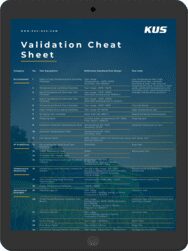A critical element of designing and manufacturing new vehicle or engine components is to confirm that they work as intended. The industry has developed myriad different types of tests to validate critical performance features. When your supplier decides on which tests to perform on a component, it’s necessary for them to consider any and all conditions under which a part will operate. Avoid cutting corners or overlooking any kind of test that will help ensure the safe operation of a component.
When and Why You Need Validation
Validation is important to the integrity of your products. It helps ensure functionality, safety, life expectancy of components, and compliance, not to mention your company’s reputation. It is important for all components but especially for custom components, since these are modified to your precise specifications. When considering the cost of customization, the validation must be worked into the budget.
Types of Validation Testing: Checklist
In order to make sure you get your component tested for everything necessary, use this checklist as a reference to get started. You may require some or all of these. Make sure to consult with your supplier or manufacturer to double check that you’re covering all possible validations for the type of component you’re purchasing.
☐ Accuracy test
☐ Appearance check
☐ Cleanliness test
☐ Color difference analysis
☐ Conductivity test
☐ Contact discharge
☐ Drop test
☐ Electric performance test
☐ Intergranular corrosion analysis
☐ Mechanical performance test
☐ Metal material elemental analysis
☐ Metallurgical analysis
☐ Nozzle atomization test
☐ pH test
☐ Simulation test
☐ Salt-spray test
☐ Strain test
☐ Sine/random vibration test
☐ Structure validation
☐ Sulfuration performance test
☐ Temperature/thermal test
☐ Tensile strength test for rubber or plastic
☐ Thawing test
☐ Urea concentration
☐ Waterproof test
At times, you will require various combinations of these tests, for example a vibration test with temperature and humidity change
Advantages of In-House Validation
When you source new components from a manufacturer, they will often send them out to a lab — even multiple labs — for validation testing. You can eliminate these extra steps by choosing a components manufacturer with in-house testing facilities. In-house testing by the manufacturer is faster, less expensive, and customizable to your needs.
This is especially important when purchasing custom components, where validation can be one of the most costly aspects, running into the tens of thousands of dollars. When a manufacturer must send components to an outside lab for testing, they incur costs that they will eventually pass along to the customer.
KUS has extensive in-house validation capabilities, and can even customize testing to your exact needs. With KUS, testing is part of the agreement. Meanwhile, most of our competitors send components to outside labs.
We can perform at least 80 different tests including all of those on the checklist above. We’ve conveniently compiled an in-depth guide to showcase our most frequently performed tests. Our laboratory spans 1,600 square meters and includes a vibration, electronics, aging, durability, mechanics, and chemical lab along with a measurement center. It is certified by ISO 17025, which is accredited by CNAS and CNCA.
If you are looking for the highest quality manufacturing with in-house validation capabilities, contact KUS today.

